名词化结构范本
- 格式:docx
- 大小:37.13 KB
- 文档页数:3
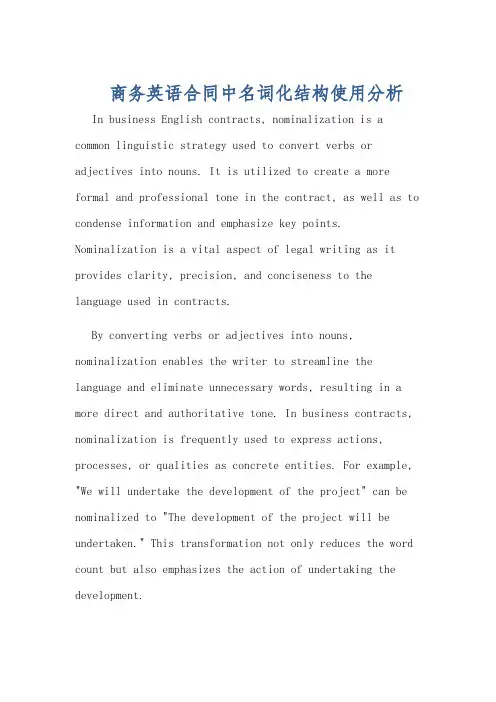
商务英语合同中名词化结构使用分析In business English contracts, nominalization is a common linguistic strategy used to convert verbs or adjectives into nouns. It is utilized to create a more formal and professional tone in the contract, as well as to condense information and emphasize key points. Nominalization is a vital aspect of legal writing as it provides clarity, precision, and conciseness to the language used in contracts.By converting verbs or adjectives into nouns, nominalization enables the writer to streamline the language and eliminate unnecessary words, resulting in a more direct and authoritative tone. In business contracts, nominalization is frequently used to express actions, processes, or qualities as concrete entities. For example, "We will undertake the development of the project" can be nominalized to "The development of the project will be undertaken." This transformation not only reduces the word count but also emphasizes the action of undertaking the development.Moreover, nominalization in business English contracts serves to emphasize key points and make them more prominent within the text. By turning verbs or adjectives into nouns, the writer can highlight important concepts and make them stand out in the document. For instance, "The company will provide financial support" can be nominalized to "The provision of financial support by the company." This nominalized form places greater emphasis on the provision of financial support, making it a central point in the contract.Furthermore, nominalization aids in creating a more formal and professional tone in business contracts. By using nouns instead of verbs or adjectives, the language becomes more sophisticated and appropriate for legal documents. This formal tone is essential for establishing the seriousness and authority of the contract, as well as for ensuring that the terms and conditions are clearly articulated.In summary, nominalization is a crucial linguistic tool in business English contracts. It helps to condense information, emphasize key points, and create a formal tonewithin the document. By converting verbs or adjectives into nouns, nominalization enhances the clarity, precision, and professionalism of the language used in contracts.在商务英语合同中,名词化是一种常见的语言策略,用于将动词或形容词转化为名词。
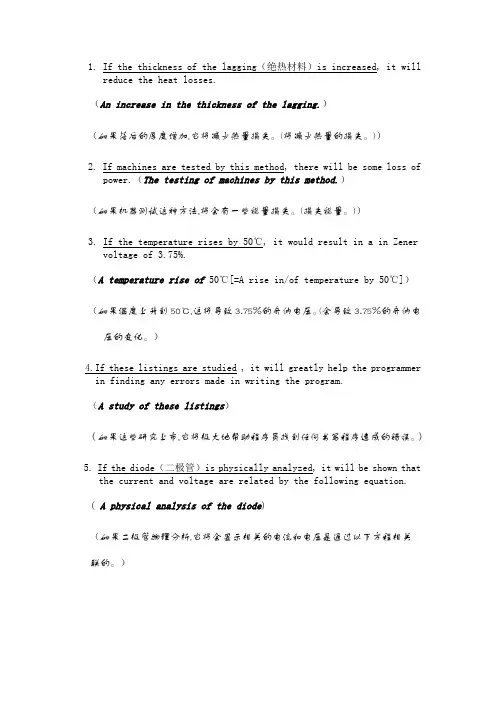
1. If the thickness of the lagging(绝热材料)is increased, it willreduce the heat losses.(An increase in the thickness of the lagging.)(如果落后的厚度增加,它将减少热量损失。
(将减少热量的损失。
))2. If machines are tested by this method, there will be some loss ofpower.(The testing of machines by this method.)(如果机器测试这种方法,将会有一些能量损失。
(损失能量。
))3. If the temperature rises by 50℃, it would result in a in Zenervoltage of 3.75%.(A temperature rise of 50℃[=A rise in/of temperature by 50℃])(如果温度上升到50℃,这将导致3.75%的齐纳电压。
(会导致3.75%的齐纳电压的变化。
)4.If these listings are studied , it will greatly help the programmerin finding any errors made in writing the program.(A study of these listings)(如果这些研究上市,它将极大地帮助程序员找到任何书写程序造成的错误。
)5. If the diode(二极管)is physically analyzed, it will be shown thatthe current and voltage are related by the following equation. ( A physical analysis of the diode)(如果二极管物理分析,它将会显示相关的电流和电压是通过以下方程相关联的。
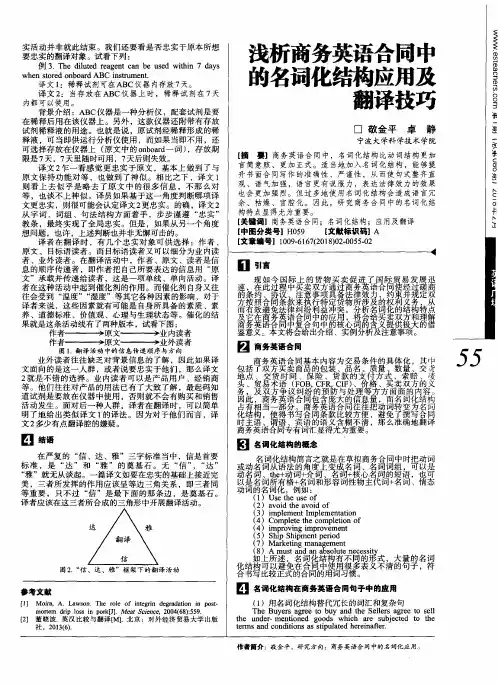
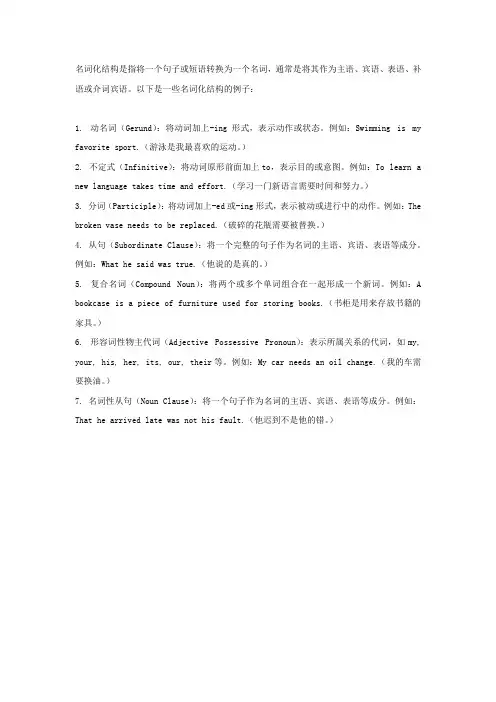
名词化结构是指将一个句子或短语转换为一个名词,通常是将其作为主语、宾语、表语、补语或介词宾语。
以下是一些名词化结构的例子:1. 动名词(Gerund):将动词加上-ing形式,表示动作或状态。
例如:Swimming is my favorite sport.(游泳是我最喜欢的运动。
)2. 不定式(Infinitive):将动词原形前面加上to,表示目的或意图。
例如:To learn a new language takes time and effort.(学习一门新语言需要时间和努力。
)3. 分词(Participle):将动词加上-ed或-ing形式,表示被动或进行中的动作。
例如:The broken vase needs to be replaced.(破碎的花瓶需要被替换。
)4. 从句(Subordinate Clause):将一个完整的句子作为名词的主语、宾语、表语等成分。
例如:What he said was true.(他说的是真的。
)5. 复合名词(Compound Noun):将两个或多个单词组合在一起形成一个新词。
例如:A bookcase is a piece of furniture used for storing books.(书柜是用来存放书籍的家具。
)6. 形容词性物主代词(Adjective Possessive Pronoun):表示所属关系的代词,如my, your, his, her, its, our, their等。
例如:My car needs an oil change.(我的车需要换油。
)7. 名词性从句(Noun Clause):将一个句子作为名词的主语、宾语、表语等成分。
例如:That he arrived late was not his fault.(他迟到不是他的错。
)。
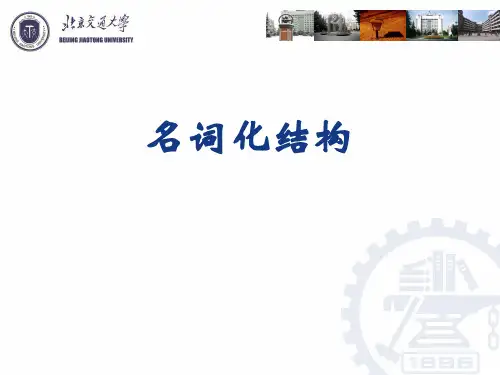

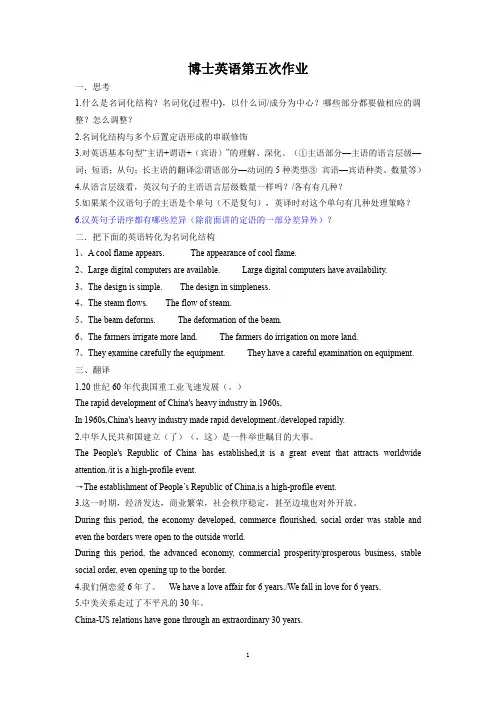
博士英语第五次作业一.思考1.什么是名词化结构?名词化(过程中),以什么词/成分为中心?哪些部分都要做相应的调整?怎么调整?2.名词化结构与多个后置定语形成的串联修饰3.对英语基本句型“主语+谓语+(宾语)”的理解、深化。
(①主语部分—主语的语言层级—词;短语;从句;长主语的翻译②谓语部分—动词的5种类型③宾语—宾语种类、数量等)4.从语言层级看,英汉句子的主语语言层级数量一样吗?/各有有几种?5.如果某个汉语句子的主语是个单句(不是复句),英译时对这个单句有几种处理策略?6.汉英句子语序都有哪些差异(除前面讲的定语的一部分差异外)?二.把下面的英语转化为名词化结构1、A cool flame appears. The appearance of cool flame.2、Large digital computers are available. Large digital computers have availability.3、The design is simple. The design in simpleness.4、The steam flows. The flow of steam.5、The beam deforms. The deformation of the beam.6、The farmers irrigate more land. The farmers do irrigation on more land.7、They examine carefully the equipment. They have a careful examination on equipment.三、翻译1.20世纪60年代我国重工业飞速发展(。
)The rapid development of China's heavy industry in 1960s,In 1960s,China's heavy industry made rapid development./developed rapidly.2.中华人民共和国建立(了)(,这)是一件举世瞩目的大事。


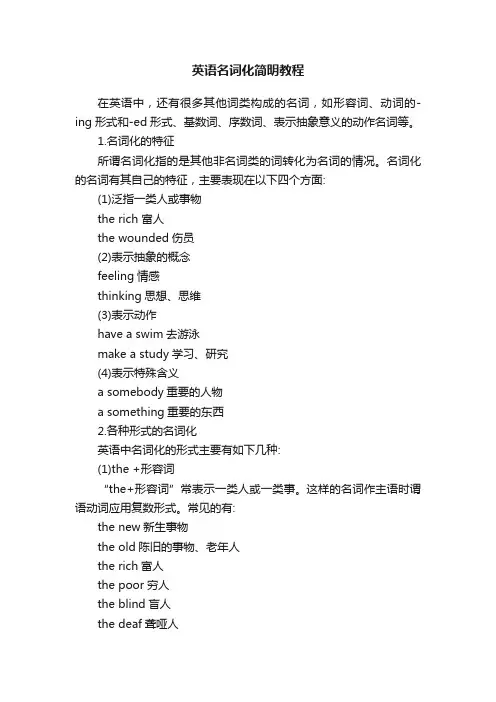
英语名词化简明教程在英语中,还有很多其他词类构成的名词,如形容词、动词的-ing形式和-ed形式、基数词、序数词、表示抽象意义的动作名词等。
1.名词化的特征所谓名词化指的是其他非名词类的词转化为名词的情况。
名词化的名词有其自己的特征,主要表现在以下四个方面:(1)泛指一类人或事物the rich 富人the wounded伤员(2)表示抽象的概念feeling情感thinking思想、思维(3)表示动作have a swim去游泳make a study学习、研究(4)表示特殊含义a somebody重要的人物a something重要的东西2.各种形式的名词化英语中名词化的形式主要有如下几种:(1)the +形容词“the+形容词”常表示一类人或一类事。
这样的名词作主语时谓语动词应用复数形式。
常见的有:the new新生事物the old陈旧的事物、老年人the rich富人the poor穷人the blind盲人the deaf聋哑人the dead死的人(2)the+动词的-ed形式the wounded伤员the unknown未知之人或事the aged老年人the beloved心爱的人the killed被杀害的人the learned有学问的人(3)动词的-ing形式the dying奄奄一息的人feeling情感suffering苦难thinking思维(4)基数词in one's fifties在某人五十几岁时in threes and fours三三两两的at sixes and sevens 乱七八糟,不和(5)序数词come out first获得第一名from the first从第一个开始need a third in the game三缺一(6)具有动作意义的名词have a look看一看have a break休息一下make a choice作出选择make a decision作出决定have a swim去游泳take a sleep睡一觉have a go试一试(7)个别不定代词Jim is really a somebody.吉姆真了不起。
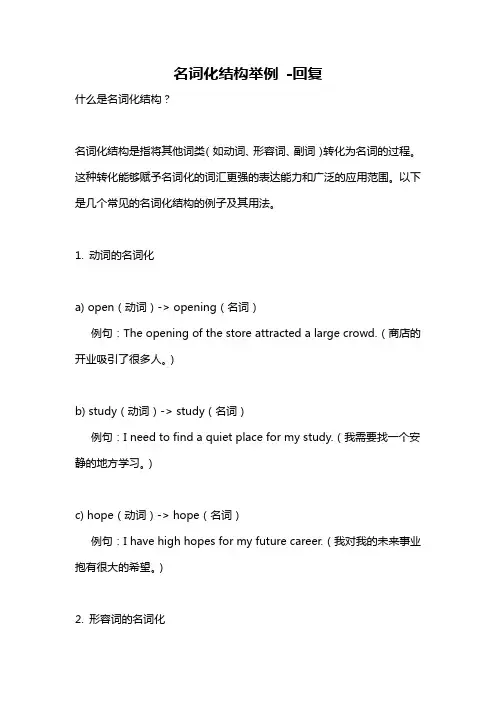
名词化结构举例-回复什么是名词化结构?名词化结构是指将其他词类(如动词、形容词、副词)转化为名词的过程。
这种转化能够赋予名词化的词汇更强的表达能力和广泛的应用范围。
以下是几个常见的名词化结构的例子及其用法。
1. 动词的名词化a) open(动词)-> opening(名词)例句:The opening of the store attracted a large crowd.(商店的开业吸引了很多人。
)b) study(动词)-> study(名词)例句:I need to find a quiet place for my study.(我需要找一个安静的地方学习。
)c) hope(动词)-> hope(名词)例句:I have high hopes for my future career.(我对我的未来事业抱有很大的希望。
)2. 形容词的名词化a) expensive(形容词)-> expense(名词)例句:Traveling to exotic destinations can be a significant expense.(去异国旅行可能会是一笔可观的开支。
)b) tired(形容词)-> tiredness(名词)例句:His tiredness was evident after working for long hours.(在长时间工作后,他的疲劳显而易见。
)c) poor(形容词)-> poverty(名词)例句:Many people are trapped in a cycle of poverty and struggle to escape.(许多人陷入贫困循环并努力摆脱。
)3. 副词的名词化a) quickly(副词)-> quickness(名词)例句:His quickness in solving problems impressed everyone.(他解决问题的迅速给大家留下了深刻印象。
科技英语中的名词化的构成类型及翻译蒋勇摘要:科技英语中名词化出现频率仅次于法律英语,本文分析了有关名词化理论的发展,简要介绍了科技英语中名词化的种类,并概括了科技英语汉译常用的方法。
关键词:科技英语;名词化;类型;翻译名词化在《现代语言学词典》中被定义为:“指从其他某个词类形成名词的过程或指从一个底层小句得出一个名词短语的派生过程。
”(克里斯特尔,2000:240)名词化被称为是“人类语言最普遍的特征之一"(Jacobs&Rosenbaum,1968:225)。
早在20世纪初,Bloomfield的描写结构主义提出:词的分类应根据词的直接成分,由派生基本词或从属向心结构即修饰语加中心词构成的都可以归入名词化范畴(Bloomfield,1914);1936年,动词到名词的转换引起Humbolldt的关注(Humbolldt,1997:250-252)。
而后,Jespersen从句法变化的角度解释了名词化,将名词化过程产生的句法变化称为“级转移”(Jespersen,1924)。
从修辞的角度看,名词化“使我们能够避免很多拖泥带水的表达,因为它表达的是本来需要用从句表达的意义”(Jespersen,1937)。
乔姆斯基的转换生成语法认为,名词化的过程是心智变化的过程,它通过一系列心理操作由深层结构转化为表层结构,这既体现了深层结构的意义,又使得语言结构更加精炼,根据乔姆斯基的理论,“名词化必须反映深层结构的特性”(Chomsky,1968:109)。
但名词化现象的不规则性,使转换生成思想在解释名词化这一现象上遇到了难题。
以Halliday 为代表的系统功能语言学从语境和交际功能的角度出发,把名词化解释为一种曲折表达事态变化的“隐喻式”表达,认为名词化是发生在语法层面的隐喻化过程,“是用名词来表现本来一致性情况下由动词或者形容词所体现的过程或者是特征”,使小句中的“过程”或“属性”经过名词化变成了“事物”,名词化后的“事物”具有双重语义特征,为重新认识名词化提供了新的研究途径。
名词化结构分析编辑名词化,作为用某一语法类别或语法结构去代替另一语法类别或语法结构的形式,在本质上涉及到一系列的变化过程。
下面几个小节将分别描述名词化过程中级的变化、语义功能的变化和部分语义成分的变化。
名词化结构的级变化如表二所示,韩礼德把语义分成三级,分别为“言辞列”(sequence)、“言辞”(figure)和“成分”(element)。
言辞是对事件的语义表达,因为人类经验主要由发生的事构成,语法通过小句的构建把这些发生的事件转换为语义。
若干表示事件的言辞构成言辞列,由小句组体现。
级阶理论容许向下移动的“级转移”(rank shift),即一个已知单位可移至下一级,但下级单位不能上移。
名词化结构用名词或名词词组代替了一致式中的小句或句组,因此“级转移”是名词化的重要内容。
例如,在下面的两个句子中:(4a) The driver drove the bus too fast down the hill, so the brakes failed.(4b) The driver’s overrapid downhill driving of the bus caused brake failure.(4a)是一致式,(4b)通过语法隐喻把(4a)的两个小句向下转移为两个名词性词组结构。
名词化的语义功能变化伴随着级向下转移,名词化结构产生了有别于一致式结构的功能意义变化(changes in status)。
韩礼德(1995a)指出,我们在进行语义分析时,要看语义功能、语法功能和语法类别三个方面的变化。
就上例而言,动词drive转化成driving时,语义功能由process 转化为entity,语法功能由transitivity转化为thing ,语法类别则由动词转化为名词。
而too fast转化为overrapid后,语义功能由circumstance转化为quality,语法功能由manner转化为epithet,语法类别则由副词转化为形容词。
动词名词化结构的英语作文In the realm of the English language, the process of verb-to-noun conversion is a fascinating linguistic phenomenon that enriches the vocabulary and provides a nuanced way to express ideas. This essay will delve into the concept of verb nounification and explore its applications in writing.Verbs are action words that describe what a subject does or experiences. However, when verbs are transformed into nouns, they become entities or concepts that can be discussed, analyzed, and contemplated. This transformation is achieved through various grammatical mechanisms, such as the addition of suffixes, the use of gerunds, and the formation of participial adjectives.One common way to convert verbs into nouns is by adding suffixes. For instance, the verb "create" can become "creation," the act of creating something. Similarly, "innovate" turns into "innovation," signifying a new idea or method. These noun forms allow writers to discuss the outcomes or products of actions without directly referencing the action itself.Gerunds are another form of verb nounification, where the -ing form of a verb is used as a noun. For example, "reading" is the gerund form of the verb "read," and it can be used in sentences like "Reading is my favorite pastime." Gerunds are particularly useful in academic writing, where they candenote processes or activities.Participial adjectives, formed by adding -ing or -ed to a verb, can also serve as nouns. For example, "interesting" is an adjective derived from the verb "interest," but it can be used as a noun in phrases like "The interesting is the life of the mind." This form allows for a more abstract discussion of qualities or states.In literature, verb nounification can add depth and sophistication to the narrative. For example, a writer might describe a character's "realization" or "discovery" to convey a moment of insight or understanding, rather than simply stating that the character "realized" or "discovered" something.In conclusion, the transformation of verbs into nouns is a powerful tool in the English language that can enhance the expressiveness and variety of writing. By understanding and utilizing verb nounification, writers can create more engaging and thought-provoking texts that resonate with readers.。
商务英语合同中的名词化结构及其语篇分析Business English is a specialized area of English language focused on the vocabulary and communication skills needed in business settings. One important aspect of business English is understanding and using noun phrases in contracts. Noun phrases, also known as nominalizations, are derived from verbs, adjectives, or other parts of speech and play a critical role in business contracts by providing clarity, conciseness, and formality to the language used.In this article, we will explore the use of noun phrases in business English contracts and analyze their role in creating effective and professional communication.1. Definition of Noun Phrases in Business ContractsNoun phrases are groups of words centered around a noun and its modifiers, which can function as subjects, objects, or complements in a sentence. In business contracts, noun phrases are commonly used to convey key terms, agreements, responsibilities, and obligations in a concise and formal manner. By turning verbs or adjectives into nouns, noun phrases help simplify complex ideas and provide a clear structure to the contract language.For example, the verb "to negotiate" can be turned into the noun phrase "negotiation," which captures the action of negotiating in a single word. Similarly, the adjective "financial" can be transformed into the noun phrase "financial terms," which refers to the specific financial conditions outlined in the contract.2. Importance of Noun Phrases in Business ContractsNoun phrases serve several important functions in business contracts:- Clarity: Noun phrases help avoid ambiguity and confusion by providing a precise and unambiguous way to express concepts and ideas. By using nouns instead of multiple words or phrases, business contracts can convey information more clearly and effectively.- Conciseness: Noun phrases allow for the compression of complex ideas into shorter, more manageable units of language. This helps reduce redundancy and unnecessary repetition, making the contract more concise and to the point.- Formality: Noun phrases lend a sense of formality and professionalism to business contracts. By using specialized terminology and structured language, noun phrases helpestablish a professional tone and convey the seriousness of the agreement.- Legal Validity: Noun phrases are a common feature of legal language and are often used in contracts to define rights, obligations, and responsibilities in a legally binding manner. By using precise and concise language, noun phrases help ensure the legal validity and enforceability of the contract terms.3. Example of Noun Phrases in Business ContractsLet's examine a sample excerpt from a business contract to illustrate the use of noun phrases:"The parties hereby agree to enter into a confidentiality agreement to protect the confidential information disclosed during the negotiation period. The terms of the agreement shall include non-disclosure obligations, intellectual property rights, and dispute resolution mechanisms."In this example, the noun phrases "confidentiality agreement," "confidential information," "negotiation period," "non-disclosure obligations," "intellectual property rights," and "dispute resolution mechanisms" play a crucial role in defining the terms and conditions of the contract. By using noun phrases, the contract language is clear, concise, and professional, makingit easier for both parties to understand and comply with the agreement.4. ConclusionIn conclusion, noun phrases are an essential feature of business English contracts, providing clarity, conciseness, formality, and legal validity to the language used. By understanding the role of noun phrases and using them effectively in business contracts, professionals can enhance their communication skills, improve their negotiation abilities, and build stronger business relationships. Mastering the use of noun phrases in business English is a valuable skill for anyone working in the business sector and can contribute to successful and effective contract negotiations.。
名词化的结构名词化结构主要是以英语名词短语代替汉语一个句子,它可以避免人称主语,从而防止句子结构过于臃肿。
法律英语常用结构复杂的长句。
从句子特征来看,还是名词结构占优势,而不是从句或动词的优势。
(1)The buyer shall furnish ocean vessels for the transportation of the rice under this contract.(2)The buyers shall give the notice of the vessel‟s name beforehand.(3)The storage of the rice shall be done in the way stated.(4)A certificate is needed attesting the existence of such event.1.动词的名词化作为一种专用英语,简洁和客观是经贸英语的灵魂,故在一般英语中用动词表示的内容,经贸英语却惯于将动词名词化,并由此产生一个名词化结构,让原来的施动意义隐含在结构的深层里。
把动词名词化,表述从“动”转为“静”,语言变得更为客观;使用动词名词化结构,可以替代一个从句甚至一个句子,语言变得更为简洁。
1.1动词名词化的基本形式就形态变化而言,经贸英语动词的名词化通常有两种:一是后缀派生法,即把-al, -sion, -tion, -ment等后缀分别加在不同的动词词尾,在句法研究中这种词称为动词派生名词(deverbal noun);二是零位派生法(zero derivation),也就是说不借助后缀直接由动词转化为名词,本文将这种词称为动词转类名词(conversion noun)。
例如:(1) the conclusion of difficult negotiations(2) the formulation of export sales contracts(3) the participation in GA TT(4) the involvement in international economy and trade activities(5) a decline in industrial production and a marked upturn in inflation(6) the fall in the growth rate of the world economy1.2动词名词化结构的两种形态动词名词化时,动词原来所带的客体和主体转化为名的修饰语或附加成分后,就构成了一个动词名词化结构,常见的形式有两种:一是动词原来所带的客体由一个介词(其中及物动词介词of)或不定式符号to引导,接在动词派生名词或动词类名词后面,形成一个后置修饰语,而主体往往以名词的格形式转化为动词派生名词或动词转类名词的前置修饰语例如:(7) Recently China reduced tariffs substantially.(8) China‟s recent substantial reduction of tariffs(9) Ericsson studied the target market carefully.(10) Ericsson‟s careful study of the target market(11) The new-to-export firm failed to treat international distributors on an equal basis with domestic counterparts.(12) the new-to-export firm‟s failure to treat international distributors on a equal basis with domestic counterparts二是客体和主体均转化为后置修饰语,客体在前,由一个介词(其中及物动词由介词of)或不定式符号to引导;主在后,通常由介词by引导。
名词化结构范本
名词化结构是一种语法现象,它把动词、形容词、副词等转化为名词形式,从而起到名词的作用。
本文将通过一些实例来介绍名词化结构的用法和表达方式。
1. 简单名词化结构
简单名词化结构是最常见的一种形式,它通常是将动词转化为名词形式。
比如,"to run"(跑步)可以转化为"running"(跑步)作为名词使用:
例句1: Running is a great way to stay fit and healthy.
这个句子中,“running”作为主语,起到了名词的作用。
例句2: I enjoy running in the park.
这个句子中,“running”作为宾语,表示一种行为或活动。
2. 形容词名词化结构
形容词也可以通过加上后缀的方式转化为名词。
比如,"dangerous"(危险的)可以转化为"danger"(危险):
例句3: We should be aware of the dangers of smoking.
这个句子中,“dangers”作为宾语,表示一种状态或情况。
例句4: The job involves a lot of physical dangers.
定的属性。
3. 名词化的副词结构
除了动词和形容词,副词也可以通过转化为名词的方式来使用。
比如,"carefully"(小心地)可以转化为"carefulness"(小心):例句5: The success of this project depends on the carefulness of our team.
这个句子中,“carefulness”作为介词“of”的宾语,表示一种性质或特点。
例句6: Her carefulness in handling delicate equipment is admirable.
这个句子中,“carefulness”作为主语的定语,修饰名词“handling”,表达一种方式或方式。
4. 名词化的短语结构
另一种常见的名词化结构是将短语转化为名词,以表示一个整体的概念。
比如,以"make a decision"(做决定)这个短语为例,可以将其转化为"decision-making"(决策):
例句7: Good decision-making is essential for successful leadership.
这个句子中,“decision-making”作为主语,表示一种行为或活动。
例句8: His poor decision-making has led to disastrous consequences.
种质量或属性。
总结:
名词化结构能够使语言更加简洁明了,丰富表达的方式。
通过将动词、形容词、副词等转化为名词形式,我们可以更好地表达一些具体
概念或抽象概念。
在运用名词化结构时,我们需要注意上下文的语法
和语义逻辑关系,确保使用正确并且符合语言习惯的表达方式。
因此,掌握名词化结构的用法对于提升语言表达能力至关重要。